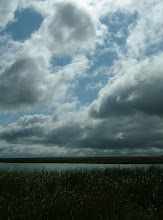
Saturday, February 23, 2008
Prairie is . . . Fire
The prairie needs sun, and trees make shade, so if left alone, trees would eventually trespass into the prairie, turning it into woodland. Thus a prairie needs fire. The fire kills the seedlings of the trees and keeps it open to the sunlight to allow the prairie grasses and forbs to grow. We in the practice of prairie restoration use to think lightning might be the agent of starting these fires, but what happens after the lightning? Rain. Nowdays, we think that Native American people were responsible for the fires, as fires seem to need to come with more regularity and frequency than random lightning would provide. So it seems the native peoples had a sophisticated means of managing the prairie for seed and berries and game. A just-burned prairie is more lush than one where previous year’s plant mass has accumulated, so that lush grass growth eventually attracts herds of grazers, which in their day was bison and deer. A just burned prairie supports cane plants like raspberries and blackberries. The seed production of the grasses and forbs is higher after a fire. This attracts more birds and allows populations of seed-eating mammals to grow. So the native people had a sustainable form of agriculture that managed the plants and animals of their native ecosystem for their use to provide food and shelter. In our home or business prairie gardens, we can use fire as a maintenance tool by burning it ourselves or hiring it done, or we can patrol for and cut out the woody ‘weeds’ and treat the stumps with a precisely targeted dose of herbicide to keep them from resproutiing, or we can mow it in the spring every few years. Like the native prairie, it will attract interesting insects, wonderful birds, and entertaining mammals, and will provide us with beautiful flowers, intriguing seedpods, and graceful waving grasses that nourish us emotionally and intellectually and aesthetically. 

Subscribe to:
Post Comments (Atom)




1 comment:
I want one of them fire hats and outfits. I'd look good in one.
Post a Comment